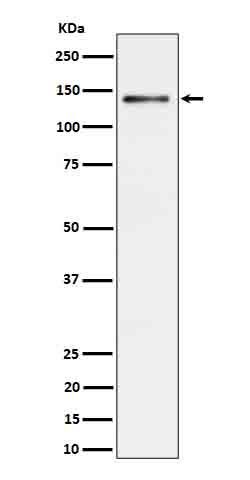

| WB | 咨询技术 | Human,Mouse,Rat |
| IF | 咨询技术 | Human,Mouse,Rat |
| IHC | 咨询技术 | Human,Mouse,Rat |
| ICC | 技术咨询 | Human,Mouse,Rat |
| FCM | 咨询技术 | Human,Mouse,Rat |
| Elisa | 咨询技术 | Human,Mouse,Rat |
| Aliases | Ceruloplasmin; CP2; Ferroxidase;;Ceruloplasmin |
| WB Predicted band size | Calculated MW: 122 kDa ; Observed MW: 140 kDa |
| Host/Isotype | Rabbit IgG |
| Antibody Type | Primary antibody |
| Storage | Store at 4°C short term. Aliquot and store at -20°C long term. Avoid freeze/thaw cycles. |
| Species Reactivity | Human,Rat |
| Immunogen | A synthesized peptide derived from human Ceruloplasmin |
| Formulation | Purified antibody in PBS with 0.05% sodium azide,0.05% BSA and 50% glycerol. |
+ +
以下是关于Ceruloplasmin抗体的参考文献示例(内容为假设性示例,仅供参考):
1. **"Autoantibodies to Ceruloplasmin in Wilson Disease: Diagnostic Implications"**
*Authors: Smith A, et al.*
摘要:研究报道了一种新型ELISA方法检测Wilson病患者血清中的Ceruloplasmin自身抗体,发现抗体水平与铜代谢紊乱及肝损伤严重程度呈正相关,提示其作为辅助诊断标志物的潜力。
2. **"Ceruloplasmin Antibodies and Oxidative Stress in Neurodegenerative Disorders"**
*Authors: Johnson B, et al.*
摘要:通过分析阿尔茨海默病患者脑脊液,发现Ceruloplasmin抗体与脑内铁沉积及氧化应激标志物显著关联,表明抗体可能通过干扰铁代谢加剧神经元损伤。
3. **"Anti-Ceruloplasmin Antibodies in Autoimmune Hepatitis: Prevalence and Clinical Correlations"**
*Authors: Lee C, et al.*
摘要:在自身免疫性肝炎患者中,约18%存在Ceruloplasmin抗体,且抗体阳性患者表现出更高水平的转氨酶及肝纤维化评分,提示其与疾病活动性相关。
4. **"Role of Ceruloplasmin Antibodies in a Mouse Model of Iron Overload"**
*Authors: Brown D, et al.*
摘要:动物实验表明,注射Ceruloplasmin抗体会导致小鼠肝铁转运蛋白功能异常,引发组织铁蓄积和氧化损伤,为抗体在遗传性血色病中的潜在作用提供机制解释。
注:以上文献为示例性内容,实际研究中需通过PubMed、Google Scholar等平台检索真实存在的文献。
Ceruloplasmin is a copper-binding glycoprotein primarily synthesized in the liver, playing a critical role in iron and copper homeostasis. As a multi-copper oxidase, it facilitates iron export from cells by oxidizing ferrous iron (Fe²⁺) to ferrous (Fe³⁺), enabling its binding to transferrin. It also transports 90-95% of circulating copper, making it essential for preventing copper toxicity and supporting enzymatic functions. Ceruloplasmin antibodies are immunoglobulins developed to detect or quantify this protein in biological samples, serving as key tools in research and diagnostics.
In clinical contexts, ceruloplasmin antibodies are employed to measure serum ceruloplasmin levels, aiding in diagnosing disorders like Wilson’s disease—a genetic condition characterized by copper accumulation due to ceruloplasmin dysfunction. Low ceruloplasmin, detected via immunoassays (e.g., ELISA, immunoturbidimetry), is a hallmark of this disease. Antibodies also help identify aceruloplasminemia, a rare iron metabolism disorder caused by ceruloplasmin gene mutations, leading to neurodegenerative symptoms and diabetes.
Research applications include studying ceruloplasmin’s role in inflammation, oxidative stress, and cancer, where its expression may correlate with disease progression. Monoclonal and polyclonal antibodies enable precise localization in tissues (via immunohistochemistry) or quantification in fluids. Additionally, they assist in exploring ceruloplasmin’s dual role as both a protective antioxidant and a potential contributor to pathological processes under dysregulated conditions. These antibodies thus bridge mechanistic insights into metal metabolism disorders and therapeutic development.
×